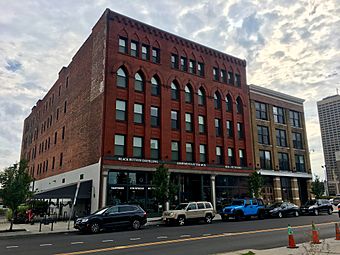Sibley and Holmwood Candy Factory and Witkop and Holmes Headquarters facts for kids
Quick facts for kids |
|
|
Sibley and Holmwood Candy Factory and Witkop and Holmes Headquarters
|
|

Sibley and Holmwood Candy Factory and Witkop and Holmes Headquarters, September 2019
|
|
| Location | 149 & 145 Swan Street, Buffalo, New York |
|---|---|
| Area | .49 acres (0.20 ha) |
| Built | 1896, 1902; 1901, 1906, 1908 |
| Architect | Lansing and Bierl; Bethune, Bethune, and Fuchs |
| Architectural style | Gothic |
| NRHP reference No. | 14000398 |
| Added to NRHP | July 11, 2014 |
The Sibley and Holmwood Candy Factory and Witkop and Holmes Headquarters are two old, connected buildings in downtown Buffalo, New York. They are also known as the Weed & Company Building. These buildings were once busy places for making candy and running a business.
Today, these historic buildings have been updated. They now hold modern apartments called "loft apartments." This means old factory spaces were turned into homes.
Contents
A Look at the Candy Factory Building
The Sibley & Holmwood Candy Factory is at 149 Swan Street. It was built in 1896. This building has five floors and is made of brick. It shows off a cool style called Gothic Revival.
Gothic Style Details
The Gothic style means it has special features. You can see pointed arches over the windows, like those found in old castles or churches. It also has fancy cast-iron columns at the front. These columns add a decorative touch. The top edge of the building has a "corbelled cornice." This is a decorative brick pattern that sticks out.
The Witkop & Holmes Headquarters
The Witkop & Holmes Headquarters is right next door at 145 Swan Street. It was built a few years later, in 1901. A famous architecture firm, Bethune, Bethune & Fuchs, designed it. This building has four floors and is also made of brick. Both buildings have flat roofs.
A Special Place in History
In 2014, these buildings were added to the National Register of Historic Places. This is a list of important places in the United States. Being on this list means the buildings are special because of their history or architecture. It helps protect them for future generations.
Images for kids




